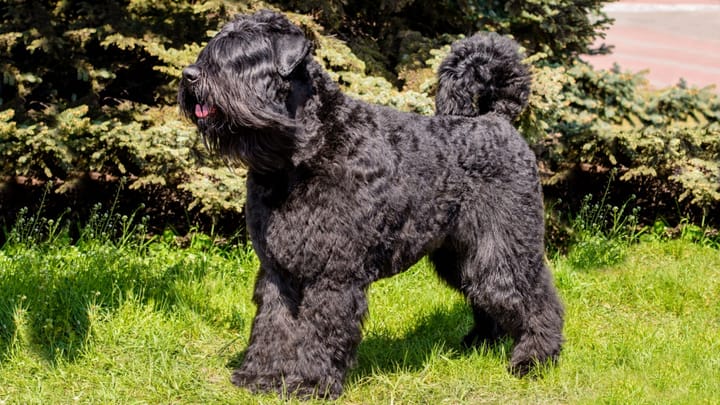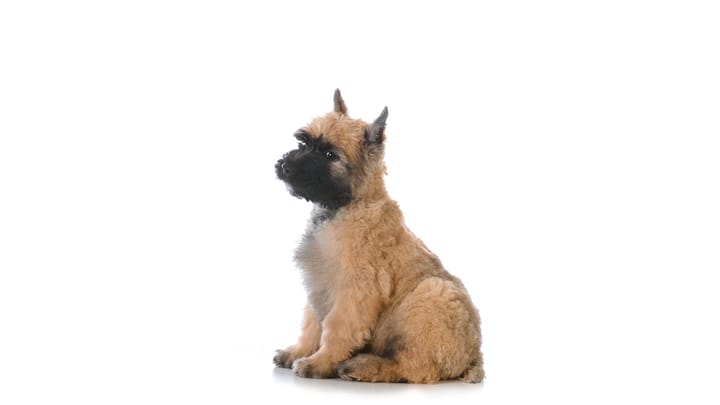Bouvier des Flandres
Other names : Belgian Cattle Dog, Flanders Cattle Dog, Vlaamse Koehond


The Bouvier des Flandres was first bred to be a working farm dog, to herd cattle, for guarding duties and pulling the farm carts. While this intelligent and hard-working canine is certainly capable of this harsh employment, he is also very suited to agility and obedience trials. However, the role that he seems to prefer is as a family companion pet.
|
Life expectancy |
The Bouvier des Flandres has a life expectancy of between 10 and 12 years |
|
Temperament |
|
|
Size |
Large
|
|
Adult size |
Female
Between 23 and 26 in
Male
Between 24 and 27 in
|
|
Adult weight |
Female
Between 60 and 77 lb
Male
Between 77 and 88 lb
|
|
Coat colour
Black, Black and Brindle, Brindle /Light/Dark/Grey/Dark Grey, Blonde, Fawn |
Black Blue |
|
Type of coat
The Bouvier des Flandres boasts a double thickness coat. The outer coat is quite shaggy looking whereas the undercoat is very dense and closer grained. |
Long |
|
Eye colour
Dark brown eyes, oval shaped. |
Brown
|
|
Purchase price |
The Bouvier des Flandres costs between £500 and £800 |
The Bouvier des Flandres, or Flanders Cattle Dog, evolved from the hardiest, working country and farm dogs. In more recent years, the modernisation of farm machinery has brought an end to the need to use the Bouvier as a working dog. More recently, he is employed as a service canine for the Defence and Police forces, or as a security guard dog.
More details about the Bouvier des Flandres
Bouvier des Flandres: Origins and history
Although his exact heritage isn’t documented, it is thought that the Bouvier descended from the Barbet, the Dutch Griffon and early Sheepdogs. During both World Wars this breed was utilised as a service dog, to locate mines and ammunition, and also as a sentry and messenger. The Breed of Bouvier des Flandres was first recognised in 1912 in Europe.
Physical characteristics of the Bouvier des Flandres
This powerful dog breed has been used to herd cattle in both Belgium and France. He has a rather rugged, forbidding look with his beard, moustache and impressive bushy eyebrows, yet actually he is a very kind and gentle dog. A well-developed head and a well-boned muzzle make up this dog’s features. The breed boasts a very strong jaw shape and triangle-shaped ears set high on his head. The breed’s front legs are straight and very powerful.
FCI classification of the Bouvier des Flandres
-
Group 1 - Sheepdogs and Cattledogs (except Swiss Cattledogs)
-
Section 2 : Cattledogs (except Swiss Cattledogs)
Bouvier des Flandres: Characteristics
Bouvier des Flandres: Behaviour
Training a Bouvier des Flandres
The Bouvier des Flandres dog is usually easy to train, providing sufficient patience, effort and time is dedicated to this task.
Bouvier des Flandres: Lifestyle
Breed compatibility Bouvier des Flandres
Bouvier des Flandres: Purchase price
Initial purchase cost between £500 to £800. Monthly costs, including pet insurance, veterinary visits, vaccinations and feeding, are between £80 to £110.
Bouvier des Flandres: Shedding
Average
Sheds hair but with weekly grooming this shedding should be kept manageable and under control.
Bouvier des Flandres: Grooming
A weekly brushing is recommended to remove the dead hair from the dog’s undercoat. Trimming the coat a few times annually is also advised.
Bouvier des Flandres: Health
A very impressive, robust dog.
Although this breed has a double coat, it doesn’t cope very well in a warm or heated situation.
He thrives in a chilly, winter climate.
Although very agile and athletic outside, he is sometimes rather lazy when in the home. Care needs to be taken with the quantity and quality of food and treats.
- Cancer
- Cataracts
- Entropion
- Gastric Torsion
- Glaucoma
- Hip Dysplasia
- Hypothyroidism
- Laryngeal Paralysis






